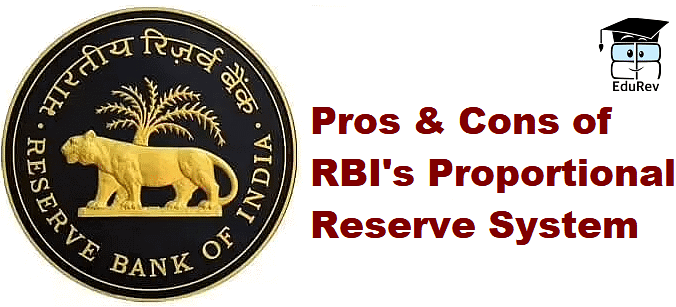Bank Exams Exam > Bank Exams Notes > SBI PO Prelims & Mains Preparation > Pros & Cons of Proportional Reserve System - RBI
Pros & Cons of Proportional Reserve System - RBI | SBI PO Prelims & Mains Preparation - Bank Exams PDF Download
Introduction
- In order to issue currency notes of different denominations, the RBI followed a system as the backing of the value of notes issued, which is known as proportional reserve system. The proportional reserve system of note issue was followed in India until 1956. The current system used for note issue is minimum reserve system which will be discussed in another article.
- Reserve bank of India maintains certain reserves. This is to provide support to the total volume of currency issued by the Reserve Bank of India. According to proportional reserve system, out of the reserves, certain percentage or proportion has to be held in the form of precious metals like gold. The remaining amount of reserves is to be maintained in the form of assets such as commercial bills or government securities. PRS was adopted in India on recommendations of Hilton Young Commission in 1927.

History of the system
- Germany was first to adopt the Proportional Reserve System of note issue in the year 1875. A number of precious metals to be maintained in the reserves usually varies from 25% (in countries like Canada and Argentina) to 40% (in countries like Germany, USA and India).
- The remaining proportion of the reserves must consist of standard securities that vary from 75% to 60%.
RBI Act, 1934
- The entire issue of currency notes is subjected to the regulations framed in the RBI Act, 1934.
- As per section 33 (2) of the RBI Act, 1934, the amount of the reserves to be maintained should be equal to the minimum of 40 per cent in gold and sterling securities where the value of gold bullion should not be less than Rs. 40 crore, for backing the issue of currency notes in India.
- This Act was amended in 1948 by replacing foreign securities in place of sterling securities. As a result, as per the proportional reserve system, the RBI had to maintain reserves equal to 40 % in gold and foreign currencies.
- The remaining 60 % was maintained by one rupee notes or rupee coins and government securities.
- The proportional reserve system proved to be very much inelastic and inflexible with the growing demand for currency notes and the security of gold.
- Therefore proportional reserve system was abolished in 1956 and the RBI Act 1935 was again amended in 1957 so as to adopt minimum reserve system of note issue.
Merits
The proportional reserve system has the following advantages:
- This system guarantees convertibility of paper currency.
- The monetary authority can issue paper currency much more than that warranted by reserves thereby it ensures elasticity in the monetary system;
- This method of note issue is economical and can be easily adopted by the developing or under-developed countries.
Demerits
The proportional reserves system has following drawbacks:
- Under this system, a large amount of precious metal lies locked in the reserve and cannot be put to productive use. This results in wastage of their use.
- It is easy to expand or increase the currency but very difficult to reduce it. The reduction of currency has deflationary effects in the economy.
- In practice, high denomination notes are converted into low denomination notes and not into coins. Therefore the convertibility of paper notes is not practical.
The document Pros & Cons of Proportional Reserve System - RBI | SBI PO Prelims & Mains Preparation - Bank Exams is a part of the Bank Exams Course SBI PO Prelims & Mains Preparation.
All you need of Bank Exams at this link: Bank Exams
|
628 videos|824 docs|280 tests
|
|
628 videos|824 docs|280 tests
|
Download as PDF

|
Explore Courses for Bank Exams exam
|

|
Signup for Free!
Signup to see your scores go up within 7 days! Learn & Practice with 1000+ FREE Notes, Videos & Tests.
Related Searches
















